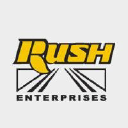/ factorpad.com / stocks / f73svs.html
An ad-free and cookie-free website.
Our quantitative data points are meant to provide a high-level understanding of factors in equity risk models for Rush Enterprises Inc-Cl A. Portfolio managers use these models to forecast risk, optimize portfolios and review performance.
We show how RUSHA stock compares to 2,000+ US-based stocks, and to peers in the Retail Trade sector and New Car Dealers industry.
Please do not consider this data as investment advice. Data is downloaded from sources we deem reliable, but errors may occur.
 Rush Enterprises, Inc. is the premier solutions provider to the commercial vehicle industry. The Company owns and operates Rush Truck Centers, the largest network of commercial vehicle dealerships in the United States, with more than 100 dealership locations in 22 states. These vehicle centers, strategically located in high traffic areas on or near major highways throughout the United States, represent truck and bus manufacturers, including Peterbilt, International, Hino, Isuzu, Ford, Mitsubishi, IC Bus and Blue Bird. It offers an integrated approach to meeting customer needs - from sales of new and used vehicles to aftermarket parts, service and body shop operations plus financing, insurance, leasing and rental. Rush Enterprises' operations also provide CNG fuel systems, telematics products and other vehicle technologies, as well as vehicle up-fitting, chrome accessories and tires.
Rush Enterprises, Inc. is the premier solutions provider to the commercial vehicle industry. The Company owns and operates Rush Truck Centers, the largest network of commercial vehicle dealerships in the United States, with more than 100 dealership locations in 22 states. These vehicle centers, strategically located in high traffic areas on or near major highways throughout the United States, represent truck and bus manufacturers, including Peterbilt, International, Hino, Isuzu, Ford, Mitsubishi, IC Bus and Blue Bird. It offers an integrated approach to meeting customer needs - from sales of new and used vehicles to aftermarket parts, service and body shop operations plus financing, insurance, leasing and rental. Rush Enterprises' operations also provide CNG fuel systems, telematics products and other vehicle technologies, as well as vehicle up-fitting, chrome accessories and tires.
Many of the following risk metrics are standardized and transformed into quantitative factors in institutional-level risk models.
Rankings below represent percentiles from 1 to 100, with 1 being the lowest rating of risk.
Stocks with higher beta exhibit higher sensitivity to the ups and downs in the market. (↑↑)
Stocks with higher market capitalization often have lower risk. (↑↓)
Higher average daily dollar volume over the past 30 days implies lower liquidity risk. (↑↓)
Higher price momentum stocks, aka recent winners, equate to lower risk for many investors. (↑↓)
Style risk factors often include measures of profitability and payout levels.
Companies with higher earnings generally provide lower risk. (↑↓)
Companies with higher dividend yields, if sustaintable, are perceived to have lower risk. (↑↓)
/ factorpad.com / stocks / f73svs.html
A newly-updated free resource. Connect and refer a friend today.